AP Biology Unit 5 - Heredity
1/54
There's no tags or description
Looks like no tags are added yet.
Name | Mastery | Learn | Test | Matching | Spaced |
|---|
No study sessions yet.
55 Terms
Haploid (represented by n)
A cell, usually a gamete or sex cell, that contains one set of chromosomes
Diploid (represented by 2n)
A cell, usually a body cell, containing two full sets or pairs or chromosomes
Gametes
Mature haploid cells, such as sperm, eg,g, and pollen
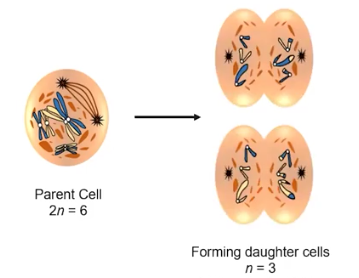
The Purpose of Meiosis
The two--round sequential series of cell division (Meiosis I & Meosis II), whose purpose is to produce 4 genetically different haploid cells from a diploid parent cell
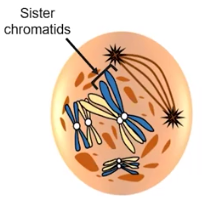
Prophase I
The first step of Meiosis I; The nuclear envelope disappears, and fibers form as DNA coils into chromosomes. These chromosomes pair based on size, shape, and DNA into homologous pairs.
Homologous Pairs
Chromosomes that code for the same genes, one from each parent, and line up together in Metaphase I
Prometaphase I
The phase between Prophase and Metaphase, where “crossing-over occurs” and homologous pairs exchange genetic information with other chromatids in different pairs
Crossing Over
The exchange of segments (information) between non-sister chromatids of double homologous chromosomes; causes the 4 daughter cells of Meiosis to be genetically different, instead of identical
Recombinant Chromatids
The result of crossing over; a recombination of genetic information that creates more genetic diversity
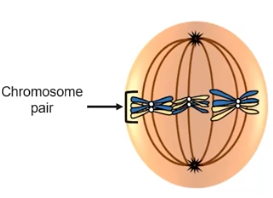
Metaphase I
The second step of Meiosis I; Fibers aline the double chromosome pairs across the center of the cell

Anaphase I
The third step of Meiosis I; Fibers separate the chromosome pairs, and each double chromosome migrates to opposite ends of the cell
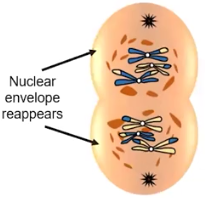
Telophase I & Cytokinesis
The final step of Meiosis I; The nuclear envelope reappears and establishes two separate nuclei, each with only one double chromosome from each pair and half the information of the parent cell. The chromosomes began to uncoil, and cytokinesis seperates the cell into two daughter cells, which are each haploid and genetically different
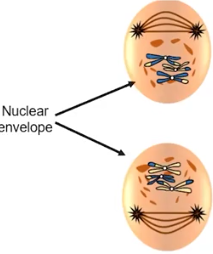
Prophase II
The first step of Meiosis II; The nuclear envelope begins to disappear and fibers form
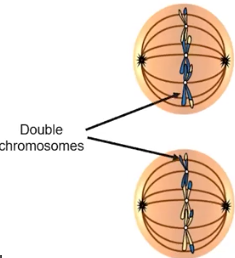
Metaphase II
The second step of Meiosis II; The fibers aline the double chromosomes across the cell
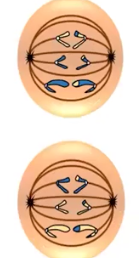
Anaphase II
The third step of Meiosis II; The fibers separate the sister chromatids, which migrate to opposite sides of the cell
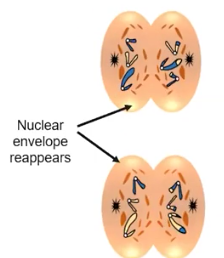
Telophase II & Cytokinesis
The final step of Meiosis II; The nuclear envelope reappears and establishes two separate nuclei, each with only one single chromosome. Cytokinesis separates the daughter cells into four daughter cells
Similarities between Mitosis & Meiosis
Both processes are 1) followed by Cytokinesis, 2) produce daughter cells, 3) have a similar notion in the way their genetic information is passed down, and 4) have the same general steps of cell division (PMAT)
Differences between Mitosis & Meiosis
Mitosis produces two genetically identical daughter cells; Meiosis produces four genetically different daughter cells with two rounds of cell division
Male vs. Female Meiosis
Female gametes mature through Meiosis II, have an unequal polar division, and cannot move; Male gametes mature during puberty, are produced continuously, have equal size, and are motile.
Gene
A unit of hereditary coding for a trait that can be inherited and transferred from one generation to the next
Trait
A genetically determined characteristic of an organism that is determined by a gene
Allele (represented by letters ex. A,a)
A specific variation of a gene that is inherited from both parents. Different allele can be inherited for the same gene
Dominant Allele (uppercase letter)
Shows in the phenotype if it is inherited
Recessive Allele (lowercase letter)
Shows in the phenotype only in the absence of an inherited dominant allele
Genotype (represented by two letters)
A combination of inherited alleles
Homozygous Genotype (AA, aa)
Genotype containing two of the same alleles
Heterozygous Genotype (Aa)
Genotype containing two different alleles
Phenotype
Physical result and expression of a genotype
Monohybrid Cross
Examines how one trait is inherited
Dihybrid Cross
Examines how two traits are inherited
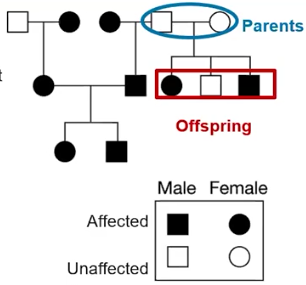
Pedigree
A visual representation of lineage, that traces back the generational history of a trait in a family; squares represent males and circles represent females
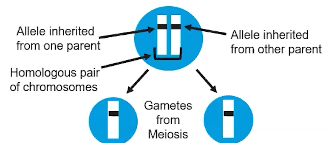
Mendel’s Law of Segregation
State that each gamete receives only one parental allele; demonstrated during Meiosis I when chromosomes are separated into daughter cells, the alleles are also separated, which allows for more genetic variation
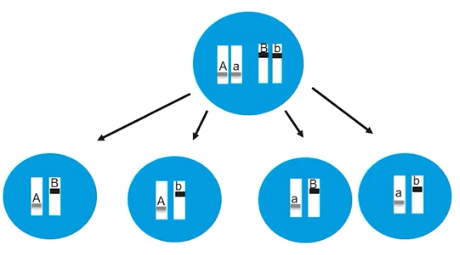
Mendel’s Law of Independent Assortment
States that genes are sorted into gametes independently of one another and are not linked or automatically inherited with another trait. Inheritance is random; allows for more possible gene combinations
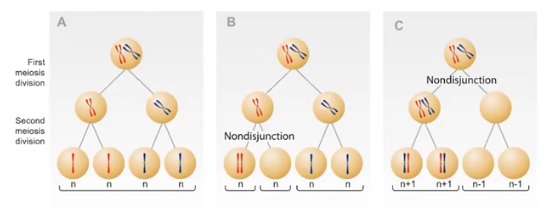
Nondisjunction
The failure of chromosomes to fully separate during the formation of gametes, which results in too many or too few sex cell chromosomes (ex. Triple X Syndrome, intersex individuals)
Mendelian Genetics
Inheritance patterns based on the principles and laws proposed by Gregor Mendel
Autosomal Dominant
Only one parent must carry the gene to pass it to the offspring; have a pedigree pattern of affected offspring with affected parents
Autosomal Recessive
Both parents must carry the gene to pass it to the offspring; have a pedigree pattern of affected offspring with carrying affected parents
Non-Mendelian Genetics
Inheritance patterns that do not follow the principles and laws proposed by Gregor Mendel

Linked Genes
Adjacent genes, close to one another on a chromosome, that are inherited together; their closeness makes them less likely to be separated during meiosis
Map Distance
Tells you the distance between genes on a chromosome or closeness of a pair of linked genes, and is determined by the frequency of genes in a “cross-over” event and map units: the lower the recombination frequency, the less likely the genes will separate & the closer they are
Sex-linked Traits
Characteristics that are determined by linked genes on sex chromosomes (ex. X^A X^a → X^A Y); explained by the Y chromosome carrying very little information
Incomplete Dominance
Neither genes are completely dominant, resulting in a blend (red & white flower = pink flower)
Codominance
Both genes are dominant, causing both to be shown (red & white flowers = red & white spotted offspring)
Multiple Alleles
There are more than just two genotypes/phenotypes (ex. blood types: A, B, AB, O)
A= I^A, I^A or i
B= I^B, I^B or i
AB= I^A, I ^B
O= i, i
Polygenic Traits
Traits influenced by more than one gene, inherited alleles have additive effect in deciding the phenotype
Non-nuclear Inheritance
The inheritance of genetic material from DNA found in the cytoplasm, not nucleus. Non-nuclear gametes, such as mitochondria (to egg instead of sperm) and chloroplasts (to ovule, instead of pollen), are maternally inherited
Lethal Allel
Allele that is only present in homozygous genotypes that cause an organism to die (dominant ex: Huntington’s, recessive example: Cystic Fibrosis)
Chi Square Analysis
By comparing observed outcomes to expected outcomes, it determines if there is a significant relationship between two groups of data- often used to test genetic crosses; it determines if data is good & non-biased or bad & biased
Chi Square Formula

Null Hypothesis
There is no relationship between the groups of data, it is unbiased, random, and by chance
Alternative Hypothesis
There is a relationship between two groups of data, with a nonrandom case
Degrees of Freedom
The number of phenotype possibilities in the cross minus one
How to calculate Chi Square Value

Chi Square Table
Values > 0.05 p are accepted
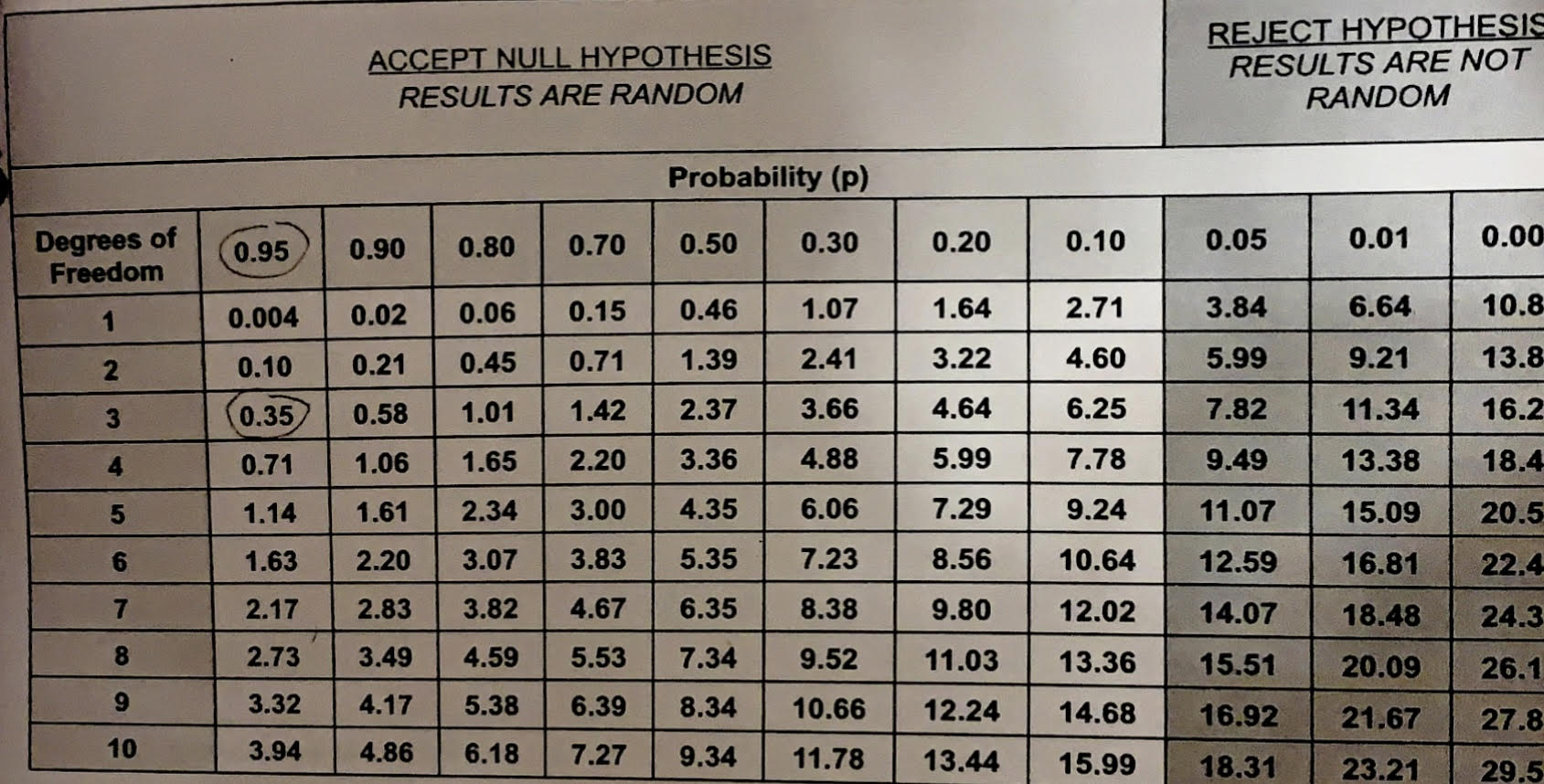
Phenotypic Plasticity
The ability for one genotype to change due to environmental or outside influences and produce more than one phenotype (ex. color of Hydrangea flowers)